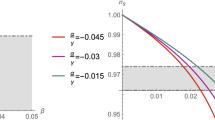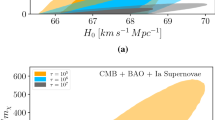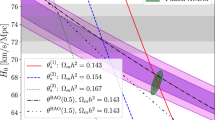Abstract
Hawking1,2 has shown that event horizons produce thermal radiation. I propose here a new cosmological model which has an early event horizon and in which the observed3 cosmic microwave background radiation is Hawking radiation. The model starts with de Sitter space—a space-time of constant curvature which is a solution to Einstein's vacuum field equations with a positive cosmological constant. Associated with an event E in de Sitter space there is a quantum barrier penetration tunnelling which leads to an open, negatively curved (k = −1) cosmology. This has an early exponential expansion phase but turns into a standard big-bang solution at late times. The geometry and quantum mechanical treatment within the future light cone of E are similar to that found in the Brout, Englert and Spindel (BES) theory4,5. This model has the following advantages: (1) It has no singularities. (2) The observed isotropy of the cosmic microwave background is explained because the different regions we observe have all been in causal contact. (3) The temperature at early epochs (T0 ∼ 1019 Ge V) is high enough to allow grand unified theories (GUTs) to produce the observed baryon excess from an initial thermal distribution through CP violations6,7. (4) T0 is correct to make the BES scenario work. (5) The early exponential expansion phase can naturally account for the observed large number n0 ∼ 1088 of particles within a volume a3 (where a is the radius of curvature) and the Guth8 flatness problem. (6) It predicts that our Universe is an open k = −1, Ω<1 cosmology consistent with the amount of mass detected in the universe so far9–11. (7) The existence of the event horizon makes it possible to create from the original de Sitter space other k = −1 universes (perhaps an infinite number) which are entirely disjoint from our own and from each other.
This is a preview of subscription content, access via your institution
Access options
Subscribe to this journal
Receive 51 print issues and online access
$199.00 per year
only $3.90 per issue
Buy this article
- Purchase on Springer Link
- Instant access to full article PDF
Prices may be subject to local taxes which are calculated during checkout
Similar content being viewed by others
References
Hawking, S. W. Nature 248, 30 (1974).
Hawking, S. W. Comm. math. Phys. 43, 199 (1975).
Penzias, A. A. & Wilson, R. W. Astrophys. J. 142, 419 (1965).
Brout, R., Englert, F. & Spindel, P. Phys. Rev. Lett. 43, 417 (1979).
Englert, F. Physical Cosmology, Les Houches Session XXXII (North-Holland, Amsterdam, 1980).
Weinberg, S. Phys. Rev. Lett. 42, 850 (1979).
Touissant, D., Treimane, S. B., Wilczek, F. & Zee, A. Phys. Rev. D19, 1036 (1979).
Guth, A. H. Phys. Rev. D23, 347 (1981).
Gott, J. R., Gunn, J. E., Schramm, D. N. & Tinsley, B. M. Astrophys. J. 194, 543 (1974).
Davis, M., Tonry, J., Huchra, J. & Latham, Astrophys. J. Lett. 238, L113 (1980).
Schramm, D. N. & Steigman, G. Astrophys. J. 243, 1 (1981).
Hawking, S. W. & Ellis, G. F. R. The Large Scale Structure of Space-Time (Cambridge University Press, 1973).
Gibbons, G. W. & Hawking, S. W. Phys. Rev. D15, 2738 (1977).
Press, W. H. Proc. Moriond Astrophysics Meet. (in the press).
De Witt, B. S., Quantum Gravity: The New Synthesis, Einstein Centennial (eds Israel, W. & Hawking, S. W.) (Cambridge University Press, in the press).
Wagoner, R. V. Physical Cosmology, Les Houches Session XXXII (North-Holland, Amsterdam, 1980).
Adler, S. Rev. mod. Phys. (in the press).
Bekenstein, J. D. Phys. Rev. D7, 2333 (1973).
Coleman, S. Phys. Rev. D15, 2929 (1977).
Unruh, W. G. Phys. Rev. D14, 870 (1976).
Author information
Authors and Affiliations
Rights and permissions
About this article
Cite this article
Gott, J. Creation of open universes from de Sitter space. Nature 295, 304–307 (1982). https://doi.org/10.1038/295304a0
Received:
Accepted:
Issue Date:
DOI: https://doi.org/10.1038/295304a0
This article is cited by
-
Vacuum decays around spinning black holes
Journal of High Energy Physics (2020)
-
QCD axion window and false vacuum Higgs inflation
Journal of High Energy Physics (2020)
-
Observational constraints on the tilted flat-XCDM and the untilted nonflat XCDM dynamical dark energy inflation parameterizations
Astrophysics and Space Science (2019)
-
Planck 2015 constraints on spatially-flat dynamical dark energy models
Astrophysics and Space Science (2019)
-
Measuring the Hubble constant and spatial curvature from supernova apparent magnitude, baryon acoustic oscillation, and Hubble parameter data
Astrophysics and Space Science (2019)
Comments
By submitting a comment you agree to abide by our Terms and Community Guidelines. If you find something abusive or that does not comply with our terms or guidelines please flag it as inappropriate.



